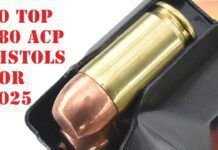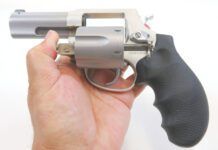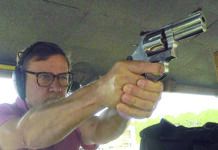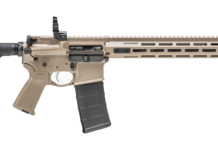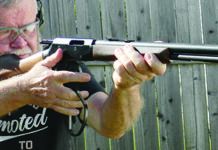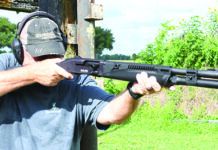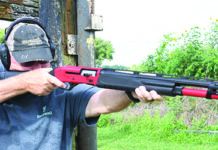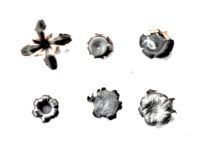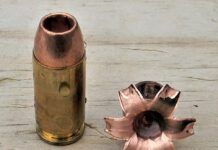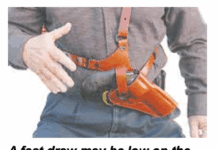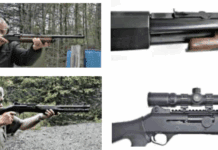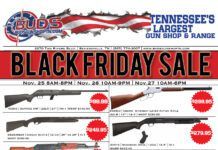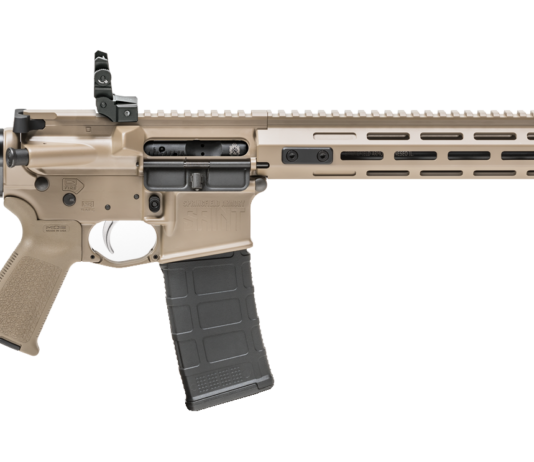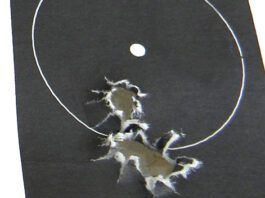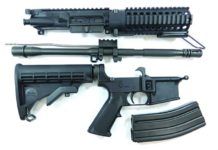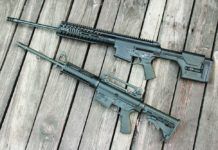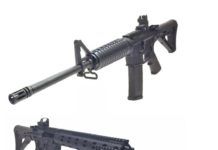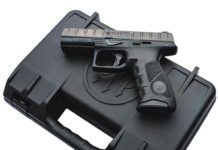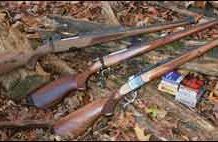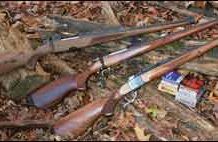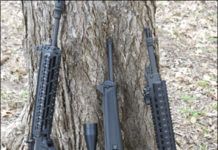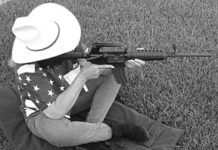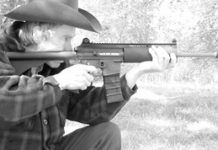Takedown ARs from DRD, Ruger, Windham: Who Takes the Cake?
Espionage novels and movies are filled with rifles that are transported in a brief case, quickly assembled, then used to fire incredibly accurate shots. But is the ability to transport a disassembled AR in a small case or knapsack more intriguing than practical? Couldn't an AR already be considered a takedown rifle? Can't you just disassemble the lower receiver from the upper receiver and tote the two pieces in a duffle bag? These were a few questions team members had as we started looking into takedown AR-15s.
On one side of the debate, a takedown AR can be discreetly carried without the normal gun case that announces to all what is inside. A takedown AR is something one might consider adding to his bug-out gear should flood, fire, or worse coming knocking on the door. Takedown ARs also have the ability to swap calibers, allowing a user to perhaps opt for 300 AAC Blackout on a pig hunt, use the 5.56mm NATO for home defense, and 9mm for low-cost training. This caliber-swap feature gives these ARs the ability to use whatever ammo is available at the moment. We've all experienced the ammunition shortages of the recent past, and there is no reason to think it won't happen again. These ARs can feed whatever ammo is available. Another plus on the takedown AR side is easier cleaning.
On the other side of the debate, parts that are assembled and reassembled wear faster than parts that are fixed, and the more complicated a design, the more likely it is to break and the harder it is to get spare parts. Also, we wondered how zero might shift when removing then replacing the same-caliber barrel? And, how would a different caliber affect point of impact? Of course, price is always a consideration, and the cost of these takedown ARs is high — more than four times the cost of an entry-level 5.56mm AR priced at about $550. Can't a shooter just buy two rifles and set them up with optics at the same cost or less?
To answer these and other questions, we gathered three models from DRD Tactical, Ruger, and Windham Weaponry. These manufacturers have taken the modularity characteristics of the AR to a new level, each offering its own unique takedown design. Operationally, the DRD and Windham are direct-gas-impingement models; the Ruger uses a piston system.
All in, these takedown rifles get smaller by separating the barrel from the rail, which we estimate as a reduction in length of about 8.5 inches. With all three takedown ARs, the rifle is broken down into three main components. One thing to note: The rails or handguards on these rifles are not compatible with aftermarket parts. You must use the handguard the AR is shipped with because it is a key part of the takedown design. You can, however, customize these ARs with other aftermarket parts like stocks, pistol grips, triggers, sights, controls, muzzle devices, and so on.
DPMS and POF 308 Semi-Autos: Heavy Hitters, or Just Heavy?
The last five years have been a roller-coaster ride for the gun industry, with an emphasis on AR-style rifles, which at one point were sold out nearly everywhere and were often selling above MSRP when you could find them. Now, AR sales are mostly down, except for a segment of the market that seems steadily abuzz, the larger caliber ARs, most commonly the 308 Winchester chambering. Most of the larger population of AR-15 owners can't be sold on the larger chambering simply because of heavier rifle weights, but steadily emerging, is a group of gun enthusiasts who seem not to be deterred by the extra weight. This is evident by the many 308-caliber AR-style guns on the market today made by many gun manufacturers, including Patriot Ordnance Factory and DPMS. These firms are not newcomers to this market; DPMS, in fact, was one of the first companies to develop and manufacture a line of 308 Win. AR rifles about 15 years ago.
We approached this test as if we were already gun owners, and we were considering whether to add a .308 semi-auto to our existing collection to add range above and beyond what our 5.56/.223 semi-autos could develop. So we chose two slightly different configurations to see what seemed like the better mix of weight, handling, and recoil. One of our test guns was a DPMS LR-308-AP4, which has an MSRP of $1269 in its base configuration (with an aluminum free-float handguard), and a suggested retail price of $1399 with an optional free-float quad-rail, as tested here. It is a 16-inch-barrel carbine with a direct-gas-impingement operating system. We pitted it against a Patriot Ordnance Factory Gen3 P308-20 BLK with an MSRP of $2599. This 20-inch-barrel rifle uses a 3-position short-stroke gas piston system to operate the action (your choice of normal, suppressed, and bolt-action operating modes).
We used a three-person test group for this evaluation, all proficient shooters in their area of interest. One was a longtime AR-15 5.56 rifle shooter and collector. The second team member prefers large-caliber bolt-action rifles, and the final member mainly shoots 22 rimfire rifles and pistols. Would trigger time behind either of these 308-caliber AR-style rifles convince them to part with a lot of money to buy one?
Two Ways to Go Lighter with An AR: M&P Versus Daniel Defense
Most gun owners choose a handgun or a shotgun for home self defense, with fewer of us picking a rifle for that job. Part of the equation certainly has to do with the portability and maneuverability of the handgun in tight spaces and, in most homes, short hallways. With a 9mm Luger or 45 ACP semi-auto or a 38/357/44 Special wheelgun, we believe we can shoot well enough with enough power and enough capacity to keep firing until the threat stops threatening us. Handguns are also easy to secure by safe or lock from nosy kids who ought not be looking in mom or dad's night stand, but who often do anyway. Other homeowners prefer the snick-snick of a pump or autoloading shotgun in 12 or 20 gauge (the gauge doesn't much matter on the receiving end). But rifles, in particular AR-15s, deserve at least a look in this area because they can be short enough, light enough, deploy enough capacity, and be powerful enough where it counts. Oddly, it is power that stops many self-defense shooters from considering the 5.56 NATO-chambered rifle for home defense, because they don't want to have to worry about penetration through sheetrock, wallboard, or even bricks. According to at least one expert, the trick is to choose the right bullet for the self-defense rifle, because the rifle itself has a lot of advantages over a handgun or shotgun.
J. Buford Boone III, owner of Boone Ballistics in Northport, Alabama, provided expert testimony for the NRA's litigation wing to challenge state attempts to restrict or ban AR-15s (Friedman v. Highland Park, NYSRPA v. Cuomo, Shew v. Malloy, and Kolbe v. O'Malley [now Hogan]), with the banning states' arguments being that civilians shouldn't own long guns that look like military rifles. NRA countered that the prevalence of the AR as a home-defense choice isn't known, and that the landmark Heller decision protects firearms that could be used by civilians in and around the home. That's where Boone's expert report comes in.
Boone has a list of ballistics credentials a mile long, one of which is that he is a retired Supervisory Special Agent (SSA) of the Federal Bureau of Investigation (FBI), and had primary oversight of the FBI Ballistic Research Facility (BRF) from April 1997 to August 2012. Boone said in his expert report, "The AR-15 rifle has characteristics that make it particularly suitable for defensive purposes."
So with Boone's endorsement in mind, we went looking for a couple of rifles that, with training, could be used by a range of folks — from husky men to small-framed women — in the close confines of a home. That meant the shortest non-SBR barrel, an adjustable-length buttstock, the ability to be fired accurately and fast with open sights or optics out to 25 yards, and either the ability to accept a light or have a handguard shaped appropriately so a light could be held with the front hand. We found two very different approaches that, naturally, cost very different dollars.
Beretta Unveils APX Striker Gun
Beretta's APX, a new striker-fired full-size pistol in 9x19mm, 9x21mm IMI and 40 Smith & Wesson cartridges, debuted at the 2015 International Defence Exhibition & Conference IDEX expo in Abu Dhabi Feb. 22.
"IDEX is one of the first venues where defense contractors present their wares to worldwide military customers and Beretta felt this was the ideal environment to present the international offering of its APX pistol," said Carlo Ferlito, general manager of Beretta and Beretta Defense Technologies (BDT) vice president.
Beretta intends to market a variant for the commercial market later this year. The new Beretta APX has an ergonomically-molded reinforced polymer frame fitted with a built-in MIL-STD-1913 Picatinny rail, interchangable backstraps and grip panels, and a modified Browning locking system. The APX is 7.56 inches long with a 4.25-inch barrel.
The trigger can be considered a light double action, with a 6-pound break, 0.2 inch of travel, and a 0.12-inch reset. The rear portion of the striker slightly protrudes from a round slot on the back of the slide as a loaded-chamber indicator.
The slide is machined from stainless steel and has a nitride coating that reduces glare, scratches, and corrosion. Other features include wide front and rear slide serrations, three-dot sights dovetailed into the slide, and no manual safety save for a Glock-style trigger safety.
Ferlito said, "Beretta waited to enter the striker-fired market until we had a pistol we knew would meet the needs of the operator. The APX has been more than three years in development. We tested it extensively with professional end users and incorporated that feedback at every opportunity. The result is a pistol platform that delivers superior performance in durability, reliability, accuracy and ergonomics."
A slot on the frame allows the use of a tool to decock it before it can be field-stripped by operating a lever found on the left side of the frame.
An optional manual safety system will be available upon request, consisting of a frame-mounted two-position switch. A reversible magazine-release catch and a factory ambidextrous slide stop/hold open release lever help make the pistol suitable for left- or right-handed shooters.
Supplied black double-stack metal magazines have polymer bottom pads and offer 17-round capacities in 9x19mm NATO and 15-round capacities in 9x21mm IMI (9 Italian) and 40 Smith & Wesson.
Mannlicher-Style Hunting Rifles: CZ Outduels Ruger and Steyr
Mannlicher-Style Hunting Rifles: CZ Outduels Ruger and Steyr
Piston-Packing 5.56s: Kel-Tec, Sig Sauer, and Ruger Redux
Lightweight AR-15 Carbines: We Test Guns from Bushmaster, DPMS
Need a handy, dependable rifle for self-defense? Want a lightweight gun that won't stretch your arms? In this test, you can pick either gun and come out with a winner.
Light & Lighter: The Carbon 15 Packs A Wallop Without Heft
At 4.3 pounds, Professional Ordnance's Carbon 15 is the lightest AR15, and it's a very good one. Bushmaster's lightest rifle, the XM15-E2S, is also worth a close look.
Tested: A Trio of Big-Game Busters in .375 H&H Magnum
Ruger's Magnum takes the cake as a dangerous-game gun, and we also like Sako's 75 Hunter. Pass on the Winchester Model 70 Safari Express.


